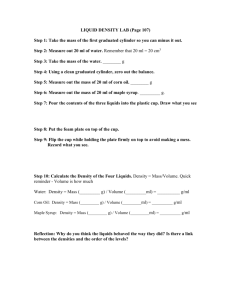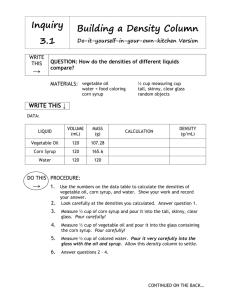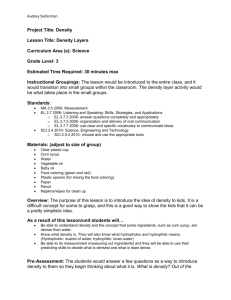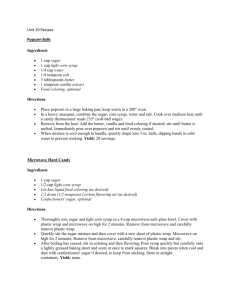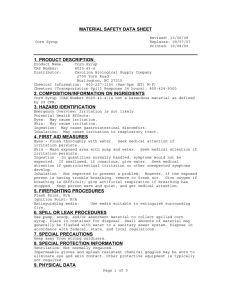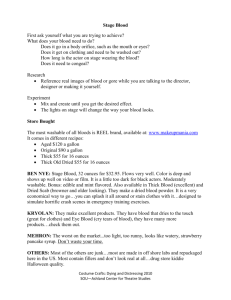LESSON 12: Density Totem - Chemical Educational Foundation
advertisement
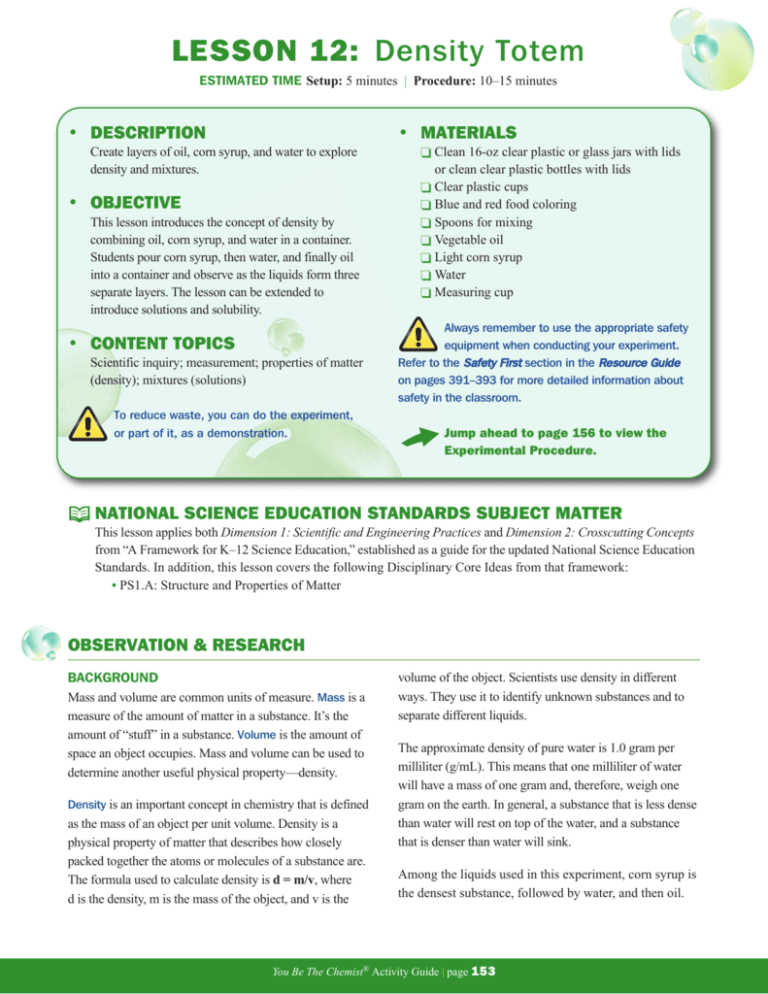
LESSON 12: Density Totem ESTIMATED TIME Setup: 5 minutes | Procedure: 10–15 minutes • DESCRIPTION • MATERIALS Create layers of oil, corn syrup, and water to explore density and mixtures. • OBJECTIVE This lesson introduces the concept of density by combining oil, corn syrup, and water in a container. Students pour corn syrup, then water, and finally oil into a container and observe as the liquids form three separate layers. The lesson can be extended to introduce solutions and solubility. • CONTENT TOPICS Scientific inquiry; measurement; properties of matter (density); mixtures (solutions) To reduce waste, you can do the experiment, or part of it, as a demonstration. Clean 16-oz clear plastic or glass jars with lids or clean clear plastic bottles with lids o Clear plastic cups o Blue and red food coloring o Spoons for mixing o Vegetable oil o Light corn syrup o Water o Measuring cup o Always remember to use the appropriate safety equipment when conducting your experiment. Refer to the Safety First section in the Resource Guide on pages 391–393 for more detailed information about safety in the classroom. Jump ahead to page 156 to view the Experimental Procedure. NATIONAL SCIENCE EDUCATION STANDARDS SUBJECT MATTER This lesson applies both Dimension 1: Scientific and Engineering Practices and Dimension 2: Crosscutting Concepts from “A Framework for K–12 Science Education,” established as a guide for the updated National Science Education Standards. In addition, this lesson covers the following Disciplinary Core Ideas from that framework: • PS1.A: Structure and Properties of Matter OBSERVATION & RESEARCH BACKGROUND Mass and volume are common units of measure. Mass is a measure of the amount of matter in a substance. It’s the amount of “stuff” in a substance. Volume is the amount of space an object occupies. Mass and volume can be used to determine another useful physical property—density. Density is an important concept in chemistry that is defined as the mass of an object per unit volume. Density is a physical property of matter that describes how closely packed together the atoms or molecules of a substance are. The formula used to calculate density is d = m/v, where d is the density, m is the mass of the object, and v is the volume of the object. Scientists use density in different ways. They use it to identify unknown substances and to separate different liquids. The approximate density of pure water is 1.0 gram per milliliter (g/mL). This means that one milliliter of water will have a mass of one gram and, therefore, weigh one gram on the earth. In general, a substance that is less dense than water will rest on top of the water, and a substance that is denser than water will sink. Among the liquids used in this experiment, corn syrup is the densest substance, followed by water, and then oil. You Be TheLESSON Chemist®Activity Activity Guide Guides | page 153 1: Goofy Putty 153 LESSON 12: Density Totem When these substances are gently added together in a container, they will form layers based on their density. Therefore, the syrup will rest on the bottom, water will be suspended in the middle, and the oil will rest on top. FORMULAS & EQUATIONS Density is the mass of an object per unit of volume. The density of an object can be calculated using the following equation: d = m/v Density is measured in grams per milliliters or grams per cubic centimeters. One cubic centimeter (cm3 or cc) is equal to one milliliter (mL). Tap water is a mixture of pure water, minerals, and other substances. The chemical formula for pure water is H2O. CONNECT TO THE YOU BE THE CHEMIST CHALLENGE For additional background information, please review CEF’s Challenge study materials online at http://www.chemed.org/ybtc/challenge/study.aspx. • Additional information on mass, volume, and density can be found in the Measurement section of CEF’s Passport to Science Exploration: The Core of Chemistry. HYPOTHESIS uCorn syrup, vegetable oil, and water have different densities and will form layers with the least dense liquid resting on the top and the densest liquid on the bottom. Triglycerides are the main component of vegetable oil. A triglyceride is a chemical compound formed from one molecule of glycerol and three fatty acids. Triglycerides have lower densities than water. When solid, they are called “fats” or “butters”; when liquid, they are called “oils.” Vegetable oils have a density of approximately 0.9 g/mL. Corn syrup is a sweet syrup produced by milling corn into cornstarch and then putting the cornstarch through the process of acid hydrolysis. The density of corn syrup is approximately 1.4 g/mL. Corn syrup is almost entirely made of dextrose, a sugar. Dextrose is also known as glucose. Fun Fact Bone density is a medical term that describes the amount of mineral content in a certain volume of bone. It is measured using a special X-ray and used to diagnose the bone High-fructose corn syrup (HFCS) is different from regular corn syrup. HFCS, an ingredient in many snacks and soft drinks, is a combination of glucose and fructose, generally with about 55% fructose. disease osteoporosis. The chemical formula for dextrose (glucose) is C6H12O6. The chemical formula for fructose is C6H12O6. Dextrose (glucose) and fructose are structural isomers, which means that their chemical formula is the same, but their atoms are arranged in a completely different order. You Be The Chemist® Activity Guide | page 154 LESSON 12: Density Totem DIFFERENTIATION IN THE CLASSROOM LOWER GRADE LEVELS/BEGINNERS Conduct the experiment as described on page 156, but spend more time on measurement. Have students take different measurements of the liquids if you have the necessary equipment. For example, measure the mass of a 1 /3 measuring cup on a balance. Then, add the liquid to the measuring cup, and measure the mass again. Have the students subtract the mass of the measuring cup from the mass of the cup with the liquid inside to figure out the mass of the liquid. Then have students calculate the density of the liquid using the density formula. Inform students that 1 /3 cup is equal to approximately 78 mL. If you don’t have the necessary equipment, discuss how they could find the mass and volume of the substances, and then use some examples to practice calculating density. HIGHER GRADE LEVELS/ADVANCED STUDENTS DESCRIPTION Add oil, corn syrup, and water to a container to form three separate layers as a result of density differences. OBJECTIVE This lesson introduces the concepts of density and solubility by combining oil, corn syrup, and water in a container. Students pour corn syrup, then water, and finally oil into a container and observe as the liquids form three separate layers. OBSERVATION & RESEARCH Mixtures are all around us, and many can be found in our kitchens! A mixture is made of two or more substances that are combined physically. When you combine peanut butter and jelly on bread, you create a mixture. A solution is a specific type of mixture. A solution is a uniform mixture in which one or more substances (solutes) are dissolved in another substance (solvent). Dissolving sugar in water creates a solution. The solute is sugar, and the solvent is water. In addition, solubility is a physical property that describes the ability of a chemical substance (the solute), to dissolve in a solvent to create a uniform solution. A substance that dissolves in another substance is soluble. For example, sugar and salt are soluble in water. If a substance does not dissolve, it is insoluble. For instance, butter is insoluble in water. A miscible liquid is a liquid that will mix in all proportions to become a uniform solution. On the other hand, oil and water are immiscible; they will not mix. Density is an important concept in chemistry that is defined as the mass of an object per unit volume. Density is a physical property of matter that describes how closely packed together the atoms or molecules of a substance are. The formula used to calculate density is d = m/v, where d is the density, m is the mass of the object, and v is the volume of the object. Scientists use density in different ways. They use it to identify unknown substances and to separate different liquids. If a solution with a lower density is added to a solution with a greater density, the less dense solution will rest on top of the denser solution. On the contrary, if a solution with a greater density is added to a solution with a lower density, the higher density solution will naturally fall to the bottom. However, if the two solutions are soluble or miscible, as the denser solution moves through the less dense solution, they will mix. CONNECT TO THE YOU BE THE CHEMIST CHALLENGE For additional background information, please review CEF’s Challenge study materials online at http://www.chemed.org/ybtc/challenge/study.aspx. • Additional information on mixtures and solutions can be found in the Classification of Matter section of CEF’s Passport to Science Exploration: The Core of Chemistry. • Additional information on density can be found in the Measurement section of CEF’s Passport to Science Exploration: The Core of Chemistry. • Additional information on solubility can be found in the Chemicals by Volume—Solutions section of CEF’s Passport to Science Exploration: Chemistry Connections. You Be The Chemist® Activity Guide | page 155 LESSON 12: Density Totem DIFFERENTIATION IN THE CLASSROOM Among the liquids used in this experiment, corn syrup is the densest substance, followed by water, and then oil. When these substances are gently added together in a container, they will form layers based on their density. Therefore, the syrup will rest on the bottom, water will be suspended in the middle, and the oil will rest on top. Oil and water are immiscible, so they will not mix. On the other hand, corn syrup, which is essentially sugar, is soluble in water. When the water is carefully added to the denser corn syrup, they do not mix right away because of their different densities. However, if you put the lid tightly on your density totem and shake it, all three substances will mix together. If you then let the container sit for a few minutes, the oil will separate out and rise back to the top, but the corn syrup and water will be permanently mixed together. Shaking the density totem causes the corn syrup to dissolve in the water. EXPERIMENTATION As the students perform the experiment, challenge them to identify the independent, dependent, and controlled variables, as well as whether there is a control setup for the experiment. (Hint: If other substances of different densities are added, will the results change?) Review the information in the Scientific Inquiry section on pages 14–16 to discuss variables. EXPERIMENTAL PROCEDURE 1. Add 1/3 cup of water to two clear plastic cups. Add two drops of blue food coloring to each cup of water and stir. 2. Carefully add 1/3 cup of corn syrup to the first cup of water. Then, add 1/3 cup of vegetable oil to the second cup of water. 3. Make a prediction: What do you think will happen if 6. Next, pour 1/3 cup of oil into one of the clean plastic cups, 1/3 cup of water into the second plastic cup, and 1/3 cup of corn syrup into the third plastic cup. 7. Add two drops of blue food coloring to the cup of water, and add two drops of red food coloring to the cup of corn syrup. Stir both cups. you combine corn syrup and vegetable oil? 4. Test your prediction by putting 1/3 cup of oil in the third plastic cup. Next, in a measuring cup, add two drops of red food coloring to 1/3 cup of corn syrup, and add this mixture to the oil in the plastic cup. 5. Carefully dispose of the liquids in your three plastic cups. (Do not pour the oil down the drain. Collect the oil and allow it to solidify—freeze it to speed up the process. Then, put it in the trash.) Wash the cups and dry them. 8. Pour the liquid that you think will remain on the bottom into one of the clear glass jars. Carefully add the next liquid that should rest on the bottom liquid. Don’t stir! Finally, pour in the liquid that you think will rest on top of the other two liquids. If using the higher level differentiation material: 1. Repeat steps 6–8 to make a second density totem using the other jar. 2. Put the lids tightly on both jars and shake up the contents of one of the jars. Compare the two jars. DATA COLLECTION Have students record data in their science notebooks or on the following activity sheet. For example, which substance was the densest? Which substance was the least dense? You can use the table provided in the activity sheet (or a similar one of your own) for students to record their data. You Be The Chemist® Activity Guide | page 156 LESSON 12: Density Totem ANALYSIS & CONCLUSION Use the questions from the activity sheet or your own questions to discuss the experimental data. Ask students to determine whether they should accept or reject their hypotheses. Review the information in the Scientific Inquiry section on pages 14–16 to discuss valid and invalid hypotheses. ASSESSMENT/GOALS MODIFICATIONS/EXTENSIONS Modifications and extensions provide alternate methods for performing the lesson or similar lessons. They also introduce ways to expand on the content topics presented and think beyond those topics. Use the following examples or have a discussion to generate other ideas as a class. Upon completion of this lesson, students should be able to … • Try out other liquid combinations, such as oil and vinegar or water and vinegar. The oil will rest on top of the vinegar because vinegar has a density of almost 1 g/mL. Therefore, the density of water and vinegar are about the same. • Apply a scientific inquiry process and perform an experiment. • Describe and identify different types of measurements, such as mass and volume. • Calculate the density of a solution if given mass and volume. • Understand density and why liquids of different densities can be layered. • Compare and contrast mixtures and solutions (see Differentiation in the Classroom). • Define and identify solutions, solutes, and solvents (see Differentiation in the Classroom). • Explain solubility and identify soluble and insoluble substances (see Differentiation in the Classroom). • Give example of miscible and immiscible substances (see Differentiation in the Classroom). K-4 5-8 See Lesson 23: Buoyant Butter for another introductory lesson on density. See Lesson 19: Liquid Rainbow for a more complex lesson on density. REAL-WORLD APPLICATIONS • Some people make their own oil and vinegar salad dressing—a vinaigrette. Oil and vinegar are insoluble, so they will not naturally mix together. When the liquids are added together, the oil will rest on top of the vinegar because the oil is less dense. However, continuously shaking the bottle of dressing will cause the liquids to mix temporarily, creating a special type of mixture known as an emulsion. COMMUNICATION Discuss the results as a class and review the activity sheet. Review the information in the Scientific Inquiry section on pages 14–16 to discuss the importance of communication to scientific progress. You Be The Chemist® Activity Guide | page 157 LESSON 12 ACTIVITY SHEET: Density Totem OBSERVE & RESEARCH 1. Write down the materials you see. ____________________________________________________________________ ______________________________________________________________________________________________________ ______________________________________________________________________________________________________ 2. How might these materials be used? __________________________________________________________________ ______________________________________________________________________________________________________ ______________________________________________________________________________________________________ 3. Define the following key terms. Then, provide an example of each by writing the example or drawing/pasting an image of the example. Term Definition Example (write or add image) Mass Volume Density 4. Consider what will happen when corn syrup, vegetable oil, and water are added together in a jar and why. uWrite your hypothesis. ______________________________________________________________ ______________________________________________________________________________________ ______________________________________________________________________________________ You Be The Chemist® Activity Guide | page 158 LESSON 12 ACTIVITY SHEET: Density Totem PERFORM YOUR EXPERIMENT 1. Add 1/3 cup of water each to two clear plastic cups. Add two drops of blue food coloring to each cup of water and stir. 2. Carefully add 1/3 cup of corn syrup to the first cup of water. Then, add 1/3 cup of vegetable oil to the second cup of water. 3. Make a prediction: What do you think will happen if you combine corn syrup and vegetable oil? 4. Test your prediction. Put 1/3 cup of oil in the third plastic cup. Next, in a measuring cup, add two drops of red food coloring to 1/3 cup of corn syrup. Then, add this mixture to the oil in the plastic cup. 5. Carefully dispose of the liquids in your three plastic cups. (Do not pour the oil down the drain. Collect the oil and allow it to solidify—freeze it to speed up the process. Then, put it in the trash.) Wash the cups and dry them. 6. Next, pour 1/3 cup of oil into one of the clean plastic cups. Pour 1/3 cup of water into the second plastic cup. Pour 1/3 cup of corn syrup into the third plastic cup. 7. Add two drops of blue food coloring to the cup of water. Add two drops of red food coloring to the cup of corn syrup. Stir each solution. 8. Pour the liquid that you think will remain on the bottom into one of the clear glass jars. Carefully add the next liquid that should rest on top of the bottom liquid. Don’t stir! Finally, pour in the liquid that you think will rest on top of the other two liquids. ANALYZE & CONCLUDE 1. Record your observations in the table below. Cup 1: Water and Cup 2: Water and Cup 3: Corn Syrup Corn Syrup Vegetable Oil and Vegetable Oil Record the order of the substances in the cup/jar. Jar: Water, Corn Syrup, and Vegetable Oil Top: Top: Top: Top: Middle: Bottom: Bottom: Bottom: Bottom: Which of the substances is the densest? You Be The Chemist®Activity ActivityGuides Guide | page 159 LESSON 12 ACTIVITY SHEET: Density Totem 2. What happens when you add corn syrup to the first cup of water? __________________________________________ ______________________________________________________________________________________________________ ______________________________________________________________________________________________________ 3. What happens when you add vegetable oil to the second cup of water? ____________________________________ ______________________________________________________________________________________________________ ______________________________________________________________________________________________________ 4. Predict what will happen when corn syrup and vegetable oil are added together in a plastic cup? Explain. ______________________________________________________________________________________________________ ______________________________________________________________________________________________________ ______________________________________________________________________________________________________ 5. Was your prediction correct? What happens when you add corn syrup to the cup of vegetable oil? ______________ ______________________________________________________________________________________________________ ______________________________________________________________________________________________________ 6. Which substance is the least dense? __________________________________________________________________ 7. Which substance is the densest? ______________________________________________________________________ 8. Is your hypothesis valid? Why or why not? If not, what would be your next steps? ____________________________ ______________________________________________________________________________________________________ ______________________________________________________________________________________________________ You Be The Chemist® Activity Guide | page 160 LESSON 12 ACTIVITY SHEET: Density Totem EXPAND YOUR KNOWLEDGE—ADVANCED 1. Define the following key terms. Then, provide an example of each by writing the example or drawing/pasting an image of the example. Term Definition Example (write or add image) Mixture Solution Soluble Insoluble Miscible Immiscible 2. What happens to the three liquids when you shake the jar? Why? __________________________________________ ______________________________________________________________________________________________________ ______________________________________________________________________________________________________ 3. What does the formation of a purple layer tell you about the liquids? ______________________________________ ______________________________________________________________________________________________________ ______________________________________________________________________________________________________ You Be The Chemist®Activity ActivityGuides Guide | page 161 LESSON 12 ACTIVITY SHEET: Density Totem ANSWER KEY Below are suggested answers. Other answers may also be acceptable. OBSERVE & RESEARCH Glass jars, plastic cups, food coloring, spoons, vegetable oil, light corn syrup, water, 1. Write down the materials you see. ____________________________________________________________________ measuring cup … ______________________________________________________________________________________________________ ______________________________________________________________________________________________________ Glass jars and plastic cups may be used to hold a substance. Food coloring may be used to dye 2. How might these materials be used? __________________________________________________________________ a substance. Spoons may be used to eat a food or stir a substance. Vegetable oil, light corn syrup, and water may be used in cooking. These ______________________________________________________________________________________________________ materials may be combined to compare the properties of the oil, corn syrup, and water. ______________________________________________________________________________________________________ 3. Define the following key terms. Then, provide an example of each by writing the example or drawing/pasting an image of the example. Term Definition Mass A measure of the amount of matter in a substance. Volume A physical property that measures the amount of space a substance occupies. Density A physical property of matter that describes how closely packed together the atoms of an element or the molecules of a compound are; the amount of matter per unit of volume (d = m/v). Example (write or add image) 4. Consider what will happen when corn syrup, vegetable oil, and water are added together in a jar and why. Corn syrup, vegetable oil, and water have different densities and will form layers, with uWrite your hypothesis. ______________________________________________________________ the least dense liquid resting on the top and the densest liquid on the bottom. ______________________________________________________________________________________ ______________________________________________________________________________________ You Be The Chemist® Activity Guide | page 162 LESSON 12 ACTIVITY SHEET: Density Totem ANSWER KEY Below are suggested answers. Other answers may also be acceptable. PERFORM YOUR EXPERIMENT 1. Add 1/3 cup of water each to two clear plastic cups. Add two drops of blue food coloring to each cup of water and stir. 2. Carefully add 1/3 cup of corn syrup to the first cup of water. Then, add 1/3 cup of vegetable oil to the second cup of water. 3. Make a prediction: What do you think will happen if you combine corn syrup and vegetable oil? 4. Test your prediction. Put 1/3 cup of oil in the third plastic cup. Next, in a measuring cup, add two drops of red food coloring to 1/3 cup of corn syrup. Then, add this mixture to the oil in the plastic cup. 5. Carefully dispose of the liquids in your three plastic cups. (Do not pour the oil down the drain. Collect the oil and allow it to solidify—freeze it to speed up the process. Then, put it in the trash.) Wash the cups and dry them. 6. Next, pour 1/3 cup of oil into one of the clean plastic cups. Pour 1/3 cup of water into the second plastic cup. Pour 1/3 cup of corn syrup into the third plastic cup. 7. Add two drops of blue food coloring to the cup of water. Add two drops of red food coloring to the cup of corn syrup. Stir each solution. 8. Pour the liquid that you think will remain on the bottom into one of the clear glass jars. Carefully add the next liquid that should rest on top of the bottom liquid. Don’t stir! Finally, pour in the liquid that you think will rest on top of the other two liquids. ANALYZE & CONCLUDE 1. Record your observations in the table below. Cup 1: Water and Cup 2: Water and Cup 3: Corn Syrup Corn Syrup Vegetable Oil and Vegetable Oil Record the order of the substances in the cup/jar. Which of the substances is the densest? Jar: Water, Corn Syrup, and Vegetable Oil Top: Vegetable oil Top: Water Top: Vegetable oil Top: Vegetable oil Bottom: Bottom: Bottom: Middle: Water Corn syrup Water Corn syrup Bottom: Corn syrup Corn syrup Water Corn syrup You Be The Chemist® Activity Guide | page 163 Corn syrup LESSON 12 ACTIVITY SHEET: Density Totem ANSWER KEY Below are suggested answers. Other answers may also be acceptable. When you add corn syrup to water, the corn syrup falls to 2. What happens when you add corn syrup to the first cup of water? __________________________________________ the bottom of the cup. ______________________________________________________________________________________________________ ______________________________________________________________________________________________________ 3. What happens when you add vegetable oil to the second cup of water? When you add vegetable oil to water, the vegetable ____________________________________ oil rests on the top of the water. ______________________________________________________________________________________________________ ______________________________________________________________________________________________________ 4. Predict what will happen when corn syrup and vegetable oil are added together in a plastic cup? Explain. Answers will vary. ______________________________________________________________________________________________________ ______________________________________________________________________________________________________ ______________________________________________________________________________________________________ 5. Was your prediction correct? What happens when you add corn syrup to the cup of vegetable oil? Answers to ______________ predictions will vary. When you add corn syrup to the vegetable oil, the corn syrup falls to the bottom of the cup and does not mix with the ______________________________________________________________________________________________________ vegetable oil. ______________________________________________________________________________________________________ 6. Which substance is the least dense? Vegetable oil is the least dense. __________________________________________________________________ Corn syrup is the densest. 7. Which substance is the densest? ______________________________________________________________________ 8. Is your hypothesis valid? Why or why not? If not, what would be your next steps? ____________________________ Answer 1: Valid because the data support my hypothesis. ______________________________________________________________________________________________________ Answer 2: Invalid because the data do not support my hypothesis. I would reject my hypothesis and could form a new one, such as … ______________________________________________________________________________________________________ You Be The Chemist® Activity Guide | page 164 LESSON 12 ACTIVITY SHEET: Density Totem ANSWER KEY Below are suggested answers. Other answers may also be acceptable. EXPAND YOUR KNOWLEDGE—ADVANCED Have students complete this section if you used the advanced differentiation information, or challenge them to find the answers to these questions at home and discuss how these terms relate to the experiment in class the next day. 1. Define the following key terms. Then, provide an example of each by writing the example or drawing/pasting an image of the example. Term Definition Mixture A physical combination of two or more substances that can be physically separated. Solution A homogeneous (uniform) mixture in which one or more substances (solutes) are dissolved in another substance (solvent). Soluble The ability of a substance to dissolve in another substance. Insoluble The inability of a substance to be dissolved into another substance. Miscible The ability to mix evenly; the ability to mix in all proportions to form a homogeneous solution. Immiscible The inability to mix evenly; the inability of two or more substances to form a homogeneous mixture when combined. Example (write or add image) All three liquids will mix when the jar is shaken, but the 2. What happens to the three liquids when you shake the jar? Why? __________________________________________ vegetable oil will separate from the other solutions when the jar is set back down. However, the water and the corn syrup will remain mixed ______________________________________________________________________________________________________ because the corn syrup is soluble in water. ______________________________________________________________________________________________________ The formation of a purple layer tells us that the 3. What does the formation of a purple layer tell you about the liquids? ______________________________________ water, dyed blue, and the corn syrup, dyed red, mix because the corn syrup is soluble in water. Shaking the jar causes these substances to ______________________________________________________________________________________________________ mix. ______________________________________________________________________________________________________ You Be The Chemist® Activity Guide | page 165
